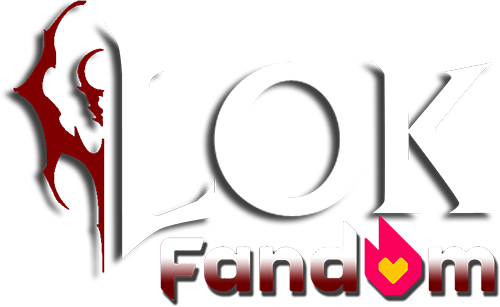Template:Term
- "We shall not cease from exploration
And the end of all our exploring
Will be to arrive where we started
And know the place for the first time." - ―T. S. Eliot
The Land of Nosgoth, usually abbreviated to Nosgoth, is a fictional setting in which the entirety of the Legacy of Kain series takes place, originally conceived by Denis Dyack, Ken McCulloch and Silicon Knights, then expanded upon by Amy Hennig and Crystal Dynamics. First entering production in 1993 and appearing in 1996's Blood Omen: Legacy of Kain, it has since been further explored and developed by ensuing entries in the series, and derives inspiration from various literary sources, including Shakespearean drama, vampire mythology, Gothic culture, Gnosticism and steampunk.
Nosgoth is regarded by characters in-game as a dying world, and each game in the series depicts different moments in the transition of the land from abundance to desolation, though in a non-sequential order. The ultimate fate of Nosgoth, and its potential redemption and restoration to its former glory, is the most-prominent and oft-recurring theme in the storyline of the overarching series, and has yet to be resolved as of Legacy of Kain: Defiance. As the majority of the games take place in the same limited area, it has consistently remained ambiguous whether Nosgoth is the name of the entire world, or a region. Generally, the term "Nosgoth" is used to refer to the conceptual setting overall.
Mythology
Concept art of the Circle of Nine from Blood Omen: Legacy of Kain.
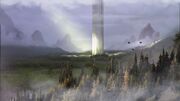
Concept art of the Pillars of Nosgoth from Soul Reaver 2.
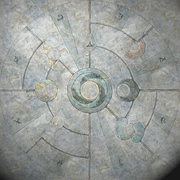
A diagram outlining the relationship between Nosgoth's magical principles.
Nosgoth is a fictional setting, incorporating elements of fantasy, steampunk and science-fiction.[1] It shares several features and traditions common to other fictional worlds, being introduced as an analogue to medieval Europe, involving "sword and sorcery", supernatural creatures and futuristic technology. Nosgoth's eras also include many parallels to real-world human history, with elements resembling creation/salvation myths, medieval kingdoms and knighthood, the Crusades, the Reformation and Renaissance, and the Industrial Revolution, all at appropriate times (under such a system, the birth, rise and fall of Kain's empire roughly corresponds to the 20th century and beyond).
Principles
The metaphysics of Nosgoth can be divided into nine magical principles: Balance, Conflict, Death, Dimension, Energy, the Mind, Nature, States and Time. Further, eight of these principles can be combined to form the classical elements: Conflict and Nature are aligned to Fire, Death and States create Water, Energy and Time are associated with Earth, and the Mind and Dimension form Air. Fire and Air are associated with Light, and Water and Earth with Darkness. These principles, along with Spirit, form the basis of Nosgoth's physics and magic system. They are represented in the form of the Circle of Nine, an oligarchy of incredibly-powerful sorcerers who preside over the Pillars of Nosgoth. The Pillars are inextricably tied to the health of the land; their integrity, or lack thereof, directly influences the balance of the world.[2]
Realms
At least three separate but coterminous planes exist within the setting (usually described as "realms"); the Material Realm (the corporeal plane of the living), the Spectral Realm (the ethereal plane of the dead), and the Demon Realm (the entropic plane of demonic entities). However, even these separate dimensions are not considered to exist "outside" the boundaries of Nosgoth. The Material Realm, where time flows in a linear fashion and physics largely behave as they do in the real world, is the main setpiece of the series, but the Spectral Realm (where time is "irrelevant") and the Demon Realm both figure heavily into the series' fiction.Template:Ref-SR1-Manual-US
Time travel
In Nosgoth, although time travel exists and is available to certain individuals, history is usually immutable; the continuum of time within the setting is extremely resilient, and does not allow for the introduction of historical paradoxes. The futures of Nosgoth's inhabitants are predestined, and the concept of fatalism is a reality rather than an idea. However, the Soul Reaver introduces loopholes to this rule, and - throughout the course of the games - Kain has succeeded in changing history three times. When the time-stream is derailed, it replaces the old timeline with a new, altered iteration of history; the previous one "dies". As such, parallel histories or universes cannot exist - only the "current" timeline is considered active or "real".[3][4]
Geography
A map of Nosgoth from Blood Omen: Legacy of Kain.
Beyond its obvious nature as a fictional land, it is (deliberately) never explained what Nosgoth actually is.[5][6] Formally, it should always be referred to as the Land of Nosgoth.[5] The breadth of territory referred to under its name (including several entities that may be considered sovereign states) could suggest that Nosgoth is a continent, but it has also been indicated that it is a world or planet.
As no game has ever gone beyond the bounds of Nosgoth, and no references have been made of lands outside of it, some have speculated that it may indeed comprise an entire world, or may be a Pangaea-like supercontinent. Thus far, all maps depicting Nosgoth have presented it at a large expanse of land, with the only known ocean on the south and west.
Nosgoth is a vast realm with a diverse landscape, including mountains, forests, plains and swamps, but very little non-polar desertification. Real-world seasons such as winter are mentioned, and the land appears to have a temperate climate, similar to that of northern central Europe.Template:Ref-BO1-Misc
Landmarks
Blood Omen: Legacy of Kain sketch of the Oracle's Cave.

A Nosgoth landscape vista in Legacy of Kain: Defiance.
Legacy of Kain: Soul Reaver render of the Silenced Cathedral.

A Nosgoth landscape vista in Legacy of Kain: Defiance.
Soul Reaver 2 concept art of a cloister in the Sarafan Stronghold.

A Nosgoth landscape vista in Legacy of Kain: Defiance.
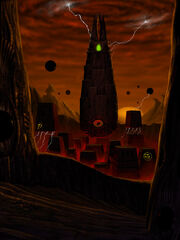
Blood Omen 2 concept art of the Eternal Prison.

A Nosgoth landscape vista in Legacy of Kain: Defiance.
Legacy of Kain: Defiance concept art of the Vampire Citadel.
As in any setting, Nosgoth's landmarks have fluctuated across its various timelines and eras; features which exist in earlier periods are wiped from the world as time progresses. A few major points of interest, however, are constant, and endure throughout several ages.
- The Air Forge: Explored in Soul Reaver 2. An ancient vampire shrine dedicated to the bearer of the Soul Reaver, designed to imbue the blade with the elemental power of Air. Located near Janos Audron's Retreat.
- The Canyons: Explored in Blood Omen 2. Wild, desertified canyons outside the city of Meridian. Though largely desolate, they are inhabited by various outlaws, and the Seer.
- The Cemetery: Recurring. A mass graveyard west of the village of Ziegsturhl, with mausoleums and temples dating back to ancient history.
- Dark Eden: Explored in Blood Omen: Legacy of Kain. An unnatural garden of horrors - straddled with lava and dead terrain - created by corrupt members of the Circle of Nine. Its dome of energy threatens to consume and warp the land.
- The Dark Forge: Explored in Soul Reaver 2. An ancient vampire shrine dedicated to the bearer of the Soul Reaver, designed to imbue the blade with the elemental power of Darkness. Located in the Swamp.
- The Drowned Abbey: Explored in Legacy of Kain: Soul Reaver. Formerly a sanctuary against the vampire menace, the Abbey was flooded and seized by the Rahabim clan, becoming their territory.
- The Eternal Prison: Explored in Blood Omen 2. A bizarre and sinister supernatural jail where natural laws are distorted. The prison guardians within claim to carry out a great experiment, supposedly restoring balance to those who have transgressed the laws of the gods and man.[7]
- The Fire Forge: Explored in Soul Reaver 2. An ancient vampire shrine dedicated to the bearer of the Soul Reaver, designed to imbue the blade with the elemental power of Fire. Located near Janos Audron's Retreat.
- The House of the Dollmaker: Explored in Blood Omen: Legacy of Kain. The residence of Elzevir the Dollmaker, situated in the center of the Lake of Lost Souls.
- The Human Citadel: Explored in Legacy of Kain: Soul Reaver. The last known enclave of free humanity after Kain's campaigns, and the headquarters of the latest incarnation of Nosgoth's vampire hunters.Template:Ref-SR1-Misc
- The Hylden City: Explored in Blood Omen 2. The Hylden Lord's base of operations, inhabited by his Hylden minions and primitive human slaves. It lies in the Great Southern Sea.
- Janos Audron's Retreat: Explored in Soul Reaver 2. A tall edifice high in the mountains, beyond the canyons north of Uschtenheim. Its aeries were constructed by the ancient vampires, and serve as the refuge of the solitary Janos Audron.
- The Land of the Nemesis: Explored in Blood Omen: Legacy of Kain. A kingdom in the north-east of Nosgoth, ruled over by a monarchy. One of its kings, William the Just, once threatened to conquer the land with his massive legions.
- The Light Forge: Explored in Soul Reaver 2. An ancient vampire shrine dedicated to the bearer of the Soul Reaver, designed to imbue the blade with the elemental power of Light. Located near the Great Southern Lake.
- The Lighthouse: Explored in Legacy of Kain: Soul Reaver. An inland lighthouse in a valley south of the Silenced Cathedral, guarded by the Turelim.
- The Lost City: Explored in Blood Omen: Legacy of Kain. An obscure and ancient city, with architecture of unclear origin, accessed via the Lake of the Dead. Its ziggurats are dominated by werewolves and other creatures.
- Malek's Bastion: Explored in Blood Omen: Legacy of Kain. A fortress perched on an isolated mountaintop in Nosgoth's northern mountains. Harsh and devoid of life, it serves as home to Malek the Paladin, the former leader of the Sarafan.
- Nachtholm Cove: Explored in Blood Omen: Legacy of Kain. A small bay where the water-bound village of Nachtholm is positioned.
- The Necropolis: Explored in Legacy of Kain: Soul Reaver. The territory of the Melchahim, and formerly a mass graveyard for humans. Its charnel houses were invaded by these vampires to replenish their declining ranks.
- Nupraptor's Retreat: Recurring. The skull-shaped fortress and hermitage of Nupraptor the Mentalist, overlooking Vasserbünde. The Retreat endures into Nosgoth's latest eras, but its façade is partially destroyed.
- The Oracle's Cave: Recurring. Moebius's arctic, labyrinthine home in the wastes of northern Nosgoth. Beneath the caves lies a complex which leads to the Chronoplast, an enormous time-streaming device which can reveal the time-stream to observers.
- The Pillars of Nosgoth: Recurring. The mythological hub of Nosgoth. Summoned before recorded history and protected by the Circle of Nine, the Pillars' health dictates the vitality of the land itself. Following their collapse, Nosgoth devolves into a wasteland.
- The Plains of Blood: Seen in Blood Omen: Legacy of Kain. A series of fields located between Avernus, the Land of the Nemesis and the Lake of Lost Souls.
- The Provincial Mines: Explored in Blood Omen: Legacy of Kain. A mine east of Willendorf, plumbed for its precious metals. An old fountain lies within, filled with the blood of the Willendorf monarchy's forefathers.
- Raziel's clan territory: Explored in Legacy of Kain: Soul Reaver. The territory of the Razielim, adjacent to the Necropolis and the Lake of the Dead.
- The Ruined City: Explored in Legacy of Kain: Soul Reaver. The mountain stronghold of the Dumahim, constructed west of the entrance to the Oracle's Cave. Attacked by vampire hunters, it lies dormant and desolate.
- The Sarafan Stronghold: Recurring. The headquarters of the Sarafan brotherhood, and, later, of Moebius's mercenary army. Constructed next to the Great Southern Lake, it is the setpiece of several important events in Nosgoth's timeline.
- The Silenced Cathedral: Explored in Legacy of Kain: Soul Reaver. Constructed as a weapon by the vampire hunters - designed to blast a deadly hymn across the land - it was seized by the Zephonim before its purpose was fulfilled.
- The Smokestack: Seen in Legacy of Kain: Soul Reaver. A giant tower-shaped furnace, designed by Kain's vampires to perpetually belch smoke into the sky and shield their empire from the effects of the sun.Template:Ref-SR1-Manual-US
- The Subterranean Ruins: Explored in Soul Reaver 2. A series of tunnels filled with crystals and ancient ruins. The Pillars of Nosgoth pass through here as they extend deep into the earth, through a chamber where the Elder God lurks.
- The Swamp: Explored in Soul Reaver 2. A dense, primeval swamp near or within the Termogent Forest. Though near-uninhabitable, it houses the ancient Dark Forge.
- The Termogent Forest: Explored in Blood Omen: Legacy of Kain. A vast, waterlogged forest fed by the Lake of the Dead. Despite its harmful nature to vampires, it is home to Vorador's Mansion.[8]
- The Tomb of the Sarafan: Explored in Legacy of Kain: Soul Reaver. The impenetrably-sealed burial place of the Sarafan warrior inquisitors, later ravaged and exposed by upheavals in the land.
- The Underworld (Defiance): Explored in Legacy of Kain: Defiance. An extensive complex of caverns and ruins beneath the Cemetery, inhabited by the Elder God's amorphous mass.
- The Underworld (SR1): Explored in Legacy of Kain: Soul Reaver. Tunnels beneath the Lake of the Dead and the Abyss, inhabited by the Elder God. Lost souls and various ruins from above exist within its confines.
- The Vampire Citadel: Explored in Legacy of Kain: Defiance. Lying within the Lake of Tears, the Citadel was once the stronghold of the ancient vampires and the Circle of Nine, but was shrouded away by magics.
- Vorador's Mansion: Recurring. Effectively a private kingdom belonging to the vampires, presided over by their patriarch, Vorador.
Settlements
A Chronoplast lamp as portrayed by Kory Heinzen.
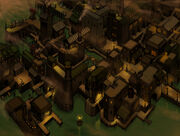
Blood Omen 2 concept art of Meridian by Steve Ross.
Legacy of Kain: Defiance artwork of the city of Avernus.
Most of the villages, towns and cities in the series are visited during eras when humans dominate Nosgoth, and thus resemble real-world settlements of the corresponding time period. Many of Nosgoth's settlements use pseudo-Germanic naming conventions, particularly in northern and central regions.
- Avernus: Recurring. Easily one of Nosgoth's largest cities, it surrounds a massive cathedral, which in turn houses secrets from ancient eras of history.
- Coorhagen: Explored in Blood Omen: Legacy of Kain. A once-wealthy, aristocratic town - described as the finest city in all of Nosgoth, rich in vanity and conceit - and the birthplace of Kain.
- Freeport: Seen in Blood Omen 2. A relatively large city, and Nosgoth's only known coastal settlement, with the exception of Meridian.
- Meridian: Explored in Blood Omen 2. Described as the capital of Nosgoth, it is the southernmost known city, lying on the coast of the Great Southern Sea. A massive industrial center, similar to Victorian London.
- Nachtholm: Explored in Blood Omen: Legacy of Kain. A village constructed on a cove, traversed by bridges. It was felt that its inhabitants and their lifestyle typified the Nosgoth populace.
- Provance: Seen in Blood Omen 2. A town situated near the Great Southern Lake, on the opposite side from Ziegsturhl. It lies directly north of Meridian.
- Stahlberg: Explored in Blood Omen: Legacy of Kain. A city on the edge of the Land of the Nemesis, and home to the most prominent libraries and universities in Nosgoth.
- Steinchencröe: Explored in Blood Omen: Legacy of Kain. A walled, well-guarded town whose inhabitants were characterized for their displeasing aroma.
- Uschtenheim: Recurring. One of the oldest villages in Nosgoth. Situated in a canyon in the northern wastes, it lies near the mountain retreat of Janos Audron.
- Vasserbünde: Explored in Blood Omen: Legacy of Kain. A town east of the Lake of Tears, lying below Nupraptor's Retreat, and to the south of Coorhagen.
- Willendorf: Explored in Blood Omen: Legacy of Kain. A prosperous kingdom, ruled over by a monarchy. It notably houses a large castle and a renowned library.
- Ziegsturhl: Explored in Blood Omen: Legacy of Kain. The smallest known village in Nosgoth, lying in the woodland region east of the Cemetery.
Bodies of water
Soul Reaver 2 artwork of the Great Southern Lake.
In Nosgoth's known regions, lakes act as the main water source; most of the events of the series occur far inland. Only one sea is known to exist.
- The Great Southern Lake: Explored in Soul Reaver 2. An enormous lake adjacent to the Sarafan Stronghold, fed by waterfalls. It lies near the Light Forge, and its lakebed contains other enigmatic ruins.
- The Great Southern Sea: Explored in Blood Omen 2. Nosgoth's only known sea, bordering Freeport and Meridian. The Eternal Prison and Hylden City are situated offshore.
- The Lake of Lost Souls: Explored in Blood Omen: Legacy of Kain. The northernmost lake known to exist in Nosgoth. The House of the Dollmaker lies on an isthmus at its center.
- The Lake of Serenity: Explored in Blood Omen: Legacy of Kain. A lake which contains two islands, the largest of which is home to the main city of Willendorf.
- The Lake of Tears: Recurring. The largest known lake in Nosgoth. Shrouded in magical mists, its waters hide the desolate remains of the Vampire Citadel.
- The Lake of the Dead: Recurring. As Nosgoth's deepest lake, it feeds into the Termogent Forest, and houses a teleporter to the Lost City.[9] Later, it becomes home to the whirling maelstrom of the Abyss, and serves as an execution ground.
History
Eras
Nosgoth's history can be divided into six distinct eras, progressing in descending chronological order:
- The era before Nosgoth's recorded history, spanning thousands of years;[10][11]
- Nosgoth's early history, spanning roughly 450 years;[10][11]
- The history preceding Blood Omen: Legacy of Kain, or pre-Blood Omen era, spanning roughly 50 years;[10][11]
- The events of Blood Omen: Legacy of Kain, or Blood Omen era, spanning less than a single year, and officially concluding with the collapse of the Pillars;[10][11]
- The era following Blood Omen: Legacy of Kain, or post-Blood Omen era, spanning roughly 500 years, and officially concluding with the raising of the lieutenants;[10][11]
- and the events of Legacy of Kain: Soul Reaver, or Soul Reaver era, spanning at least 1500 years.[10][11]
The full span of known history in Nosgoth comprises a minimum of 5500 years. Since Nosgoth's history was altered three times throughout the Legacy of Kain games, four timelines have been observed in the series. These can be informally referred to as:
- The first timeline, derailed by the first paradox;
- The second timeline, derailed by the second paradox;
- The third timeline, derailed by the third paradox;
- and the fourth timeline, which has not been derailed, and remains Nosgoth's current "living" timeline.
The full history of Nosgoth is revealed gradually as the series progresses, and important elements of the world's backstory are revealed in later timelines. Not all events are persistent between the timelines - certain aspects of history have been heavily altered or expelled as the time-stream was derailed.
However, although it is not possible to determine the full extent of the changes incurred by each paradox, it is known that history admits only the slightest alterations to the timeline during these derailments. "History abhors a paradox", and the time-stream tries to maintain its integrity to the greatest degree possible.
Events
Blood Omen: Legacy of Kain art of the vampire purge.
Blood Omen: Legacy of Kain art of the slaughter of the Circle.
Blood Omen: Legacy of Kain art of Malek's punishment.
Blood Omen: Legacy of Kain art of Ariel's murder.
Blood Omen: Legacy of Kain art of Kain in the Underworld.
Blood Omen: Legacy of Kain art of Kain's transformation.
In the aeons before Kain's birth, with the genesis of the Pillars of Nosgoth, the unspoiled land was protected by an oligarchy of sorcerers known as the Circle of Nine, nine Guardians sworn to protect and serve the Pillars.[2][10][11] When a Guardian died, the Circle would briefly remain broken, until a successor was born to assume their place; therefore, the Circle usually consisted of nine members.[11] Just as the origin of the Pillars was seemingly lost to history, the events surrounding the summoning of the Circle of Nine were also unknown; as long as the Pillars existed, there was a body of sorcerers sworn to protect them.[2][10][11] Before recorded history, the mystical sword known as the Soul Reaver was forged, and seminal individuals such as the Guardians Moebius and Mortanius, and the vampires Janos Audron and Vorador, were born.[10][11][12][13]
In Nosgoth's early history, the land's vampire population began to increase, capturing the attention of the Circle.[10][11] Fearing this "scourge", the Circle brought into existence the order of the Sarafan, a monastic order of warrior-priests devoutly loyal to their Guardian sponsors.[11] Led by Malek, Raziel and Turel, these hunters slaughtered thousands of vampires in their masters' names, culminating in the death of Janos Audron (reputed to have been Nosgoth's greatest vampire).[11][14][15][16] Upon learning of this, the vampire Vorador retaliated by infiltrating the Sarafan Stronghold, murdering six of the Guardians before humiliating Malek in battle.[10][11] Mortanius punished Malek for this failure by fusing his soul to a hellish suit of magical armor, condemning him to protect the Circle for eternity.[11] Though the Pillars culled new Guardians, the Sarafan never truly recovered after the deaths of their commanders, and the vampire purge came to its cessation before long.[10][11]
Prior to the corruption of the Pillars in the pre-Blood Omen era, Nosgoth had been a peaceful, pastoral land, overflowing with abundant life and vitality.[12] However, Mortanius - seduced by a Dark Entity bent on overthrowing the Pillars - became possessed.[2][10][11][17] Using his body as a host, the Entity murdered Ariel, the Balance Guardian; Kain was born to succeed her in this role.[10][11] Ariel's lover, the Mind Guardian Nupraptor, was driven insane by grief, and turned his abilities against his fellow Circle members, unleashing a telepathic assault which left all nine Guardians irrevocably insane and corrupt (including the infant Kain).[10][11] The Pillars themselves visibly turned gray and corroded to symbolize their patrons' mental decay.[11] While Kain matured over the years, pledging allegiance to the Lion Throne and witnessing the rise of the legions of the Nemesis, the Guardians spurned their sacred duties, and instead poisoned the land with their deranged sorcery.[11]
Recognizing the impact of his failure, Mortanius sought to redeem himself and save Nosgoth.[17] To preserve the land, the infection would have to be eliminated - all nine Guardians would need to die.[11] In his thirtieth year, still ignorant of his identity and destiny as Balance Guardian, Kain - a nobleman - embarked on a journey across Nosgoth.[11] Outside a tavern in Ziegsturhl, he was murdered by a group of brigands. In the Underworld, Mortanius offered to revive him so that he might take revenge; he readily accepted, and was reborn as a vampire, unaware that Mortanius had orchestrated the entire assassination. Kain slew his assassins, but quickly realized that the decaying Pillars held the key to his future. If he could destroy the Circle and right the Pillars, he was promised, he would find release and peace from the blood curse which now affected him.
Following direction from Mortanius and the specter of Ariel, Kain eliminated the Circle, member by member, and restored their Pillars. During his quest, Moebius - posing as the Oracle of Nosgoth - warned him of the legions of the Nemesis, and guided him to Vorador, who recounted stories of the Sarafan purges. Ignoring Vorador's counsel to stay out of human affairs, Kain chose to challenge the Nemesis' horde. He claimed the Soul Reaver and a time-streaming device from Avernus Cathedral, and traveled to Willendorf, where he was able to gain the favor of King Ottmar. Kain and Ottmar mobilized the army of the Last Hope against the legions, but in the subsequent Battle of the Last Stand, the Willendorf forces were devastated. Cornered, Kain activated the time-streaming device, and found himself fifty years in the past.
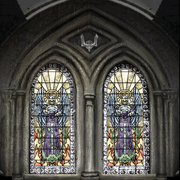
A Soul Reaver 2 mural of the Sarafan.
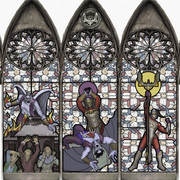
A Soul Reaver 2 mural of Janos Audron's death.

A Soul Reaver 2 mural of the battle between William and Kain.

Soul Reaver 2 mural of Nosgoth's ancient history.

Soul Reaver 2 mural of Nosgoth's ancient history.
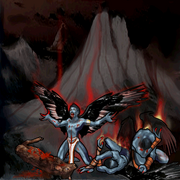
Soul Reaver 2 mural of Nosgoth's ancient history.

Soul Reaver 2 mural of Nosgoth's ancient history.
Wandering in this era before his birth, Kain realized he could kill William the Just - the young boy-king who would, in the future, become the Nemesis - and thus prevent the legions from ever coming to power. He took it upon himself to assassinate William, infiltrating his stronghold. William had been armed with that era's incarnation of the Soul Reaver by Moebius, and Kain used his own Reaver (the same sword, from the future) in battle against the youth.[17]
The convergence of two Reavers distorted time and space, enabling the introduction of the first paradox. Seizing this advantage, Kain defied history by killing William, expelling the Nemesis and shunting Nosgoth into a new, alternate timeline. As he returned to the present day, however, Kain discovered that his reckless actions had changed the land for the worse.
In this timeline, though the legions of the Nemesis never came to exist, Moebius had capitalized on the death of William, presenting him as a martyr to the citizens of the land, and thus igniting a renewed hatred of vampires among the population. His mercenary army, sponsored by the people, had launched a new crusade on the vampires; within decades, they had driven their enemies to near-extinction. Kain arrived just in time to witness the execution of Vorador, the last of the era's vampires; he retorted by defeating Moebius's mob and murdering the Time Streamer, but the damage had been done. He had been left the last surviving vampire in Nosgoth, and, summoned to the Pillars by Mortanius, he was finally forced to confront his destiny.
At last aware that Mortanius had masterminded his assassination to destroy the Circle, Kain battled the Death Guardian, and defeated the Dark Entity who arose from his corpse. As the Pillars lay on the threshold of restoration, he realized the truth - that he was the Balance Guardian, and that only his self-sacrifice could fully heal the Pillars. His final, climactic decision loomed - sacrifice himself to restore the world, or refuse the sacrifice and ensure the world's corruption. Rather than commit himself to oblivion, Kain chose the latter path, deciding to preserve the vampire race from its impending extinction and rule the world in its damnation. The collapse of the Pillars ensued.
Appreciating the irony of his decision, Kain set the ruined Pillars as the seat of his fledgling empire; the unrestored Balance Pillar served as the base of his throne.[11][18] Five centuries later, he began his conquest of the land in earnest, seeking to recruit a cadre.[11][18] As a vampire raised by necromancy, he could not "turn" a vampire via the traditional blood gift, but - by breathing a small portion of his vampire soul into a corpse - he could draw the corpse's soul back into the body, reviving it as a fledgling vampire.[11][13] Stealing into the long-forgotten Tomb of the Sarafan, he carried out this process on the six martyred inquisitors. Their well-entombed corpses - though long dead - had been spared the corruption of the grave.[11]
Going from crypt to crypt, Kain breathed his gift into each of the Sarafan corpses - Raziel, Turel, Dumah, Rahab, Zephon and Melchiah, in order, and thus raised his first-born "sons" as the lieutenants of his fledgling empire.[11] The six lieutenants had been too long dead to remember much of their human lives; they remained ignorant of their Sarafan roots, and of Kain's blasphemous private joke.[11][18] Complicit to his will, they recruited clans of their own, "turning" the corpses of their human victims to do their bidding. Within a hundred years, the humans of Nosgoth had been thoroughly domesticated by Kain's minions, and, over the ensuing centuries, the vampires evolved, their bodies adapting and transforming.[11][18][19]
Under Kain's regime, many of Nosgoth's landmarks and settlements were destroyed; humanity's last bastion became the Human Citadel, north of the now-tumultuous Lake of the Dead - now ravaged by the raging whirlpool of the Abyss.[18][20] Putting slaves to work, Kain had the Sanctuary of the Clans constructed around the remains of the collapsed Pillars - a shrine to the new age. Huge furnaces were built to belch smoke into the sky, shielding the land from the effects of the sun.[18] However, Kain ultimately realized that the Pillars had indeed been much more than a human edifice; left unrestored as they were, they could do nothing to prevent corruption from seeping into the land like a poison, turning his empire into an irredeemable wasteland.[2][18]
After Raziel's execution, Nosgoth's health declined further, and by the time of Raziel's return centuries later, the vampire clans had devolved into monstrous beasts and scattered to the corners of the land.[2][21] By this time, Nosgoth was wracked with cataclysms, putatively teetering on the brink of collapse. Channeled into battle against his mutated brethren, Raziel encountered Kain in a fateful confrontation at the Pillars; Kain raised the Soul Reaver against Raziel, which shattered when Kain attempted to strike him down. The soul-devouring sentience in the blade was thus released, and became Raziel's symbiotic weapon.[2] Strangely satisfied with this outcome, Kain lured Raziel into the northern wastes, where the two were propelled into Nosgoth's past.[2]
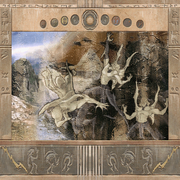
Image of the enemy race's banishment from Soul Reaver 2.
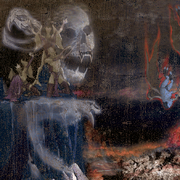
Image of the enemy race's curse in Soul Reaver 2.
In the pre-Blood Omen era, Raziel uncovered much more of Nosgoth's ancient history. Before the Pillars existed, the ancient vampires were involved in a devastating war for control of the land, battling an unidentified enemy race. The vampires raised the Pillars to exile their adversaries to the Demon Realm, but became afflicted with a predatory blood-thirst. To them, the Reaver was a holy icon, the instrument of their eventual salvation. Traveling to the Sarafan Stronghold, Raziel met with Kain, who related to him the story of the Nemesis and the first paradox. Kain argued that his fate had been artificially rigged by the earlier alteration to history; he sought to introduce more paradoxes, hoping to reclaim his original destiny to restore Nosgoth. By defying the time-stream, Raziel triggered the second paradox, prolonging Kain's life and shunting Nosgoth into another alternate timeline. Soon afterwards, he was deceived by Moebius, and found himself in the post-Blood Omen era.
In this time period, Nosgoth had been subjected to violent demon incursions due to the decay of the Binding. Exploring the Air Forge, Raziel was able to confirm that the winged race were Nosgoth's first vampires, the architects of the Pillars, and the creators of the Reaver. Their blood-thirst had been a literal curse, inflicted upon them by their vanquished enemies. Determined to speak with Janos Audron - the last survivor of the ancient vampire race - he made his way back in time to Nosgoth's early history, the era of his own, human life as a Sarafan priest.
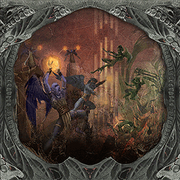
Legacy of Kain: Defiance mural of the raising of the Pillars.

Legacy of Kain: Defiance mural of the Circle of Nine.
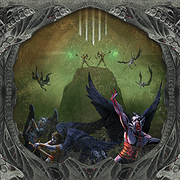
Legacy of Kain: Defiance mural of the affliction of the blood curse.

Legacy of Kain: Defiance mural of the Reaver's forging.

Legacy of Kain: Defiance mural of the human revolt.
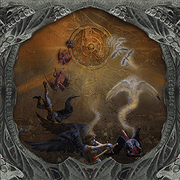
Legacy of Kain: Defiance mural of the vampires' suicide in the Elder God's name.
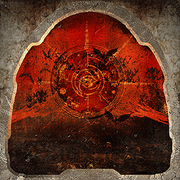
Legacy of Kain: Defiance mural of the Wheel of Fate.

Legacy of Kain: Defiance mural of the Scion of Balance.
Here, Raziel was able to meet Janos - a winged ancient - who affirmed many of the truths he had learned. As the ancient vampires fell to the blood curse, the Pillars would come under human guardianship, leading to the ancients' civilization and history being wiped out and forgotten. Ultimately, the humans came to view the vampires as a plague upon mankind, and, eventually, the friction between the humans and (a new generation of) vampires led to the instigation of the Sarafan against the vampire menace. Raziel witnessed his former, human self-murder Janos, and, motivated by a lust for revenge, pursued the Sarafan commanders, just as Vorador's slaughter of the Circle took place (also in response to Janos' murder).
Raziel discovered how he himself slaughtered the Sarafan leaders, and was his own murderer - thus becoming the catalyst not only of Kain's future empire, but of his own dark destiny.[2] Subsequently, he realized how he was fated to become the ravenous spirit imprisoned in the Soul Reaver blade - that this was, and always had been, the hellish cycle of his destiny. The Wraith Blade, he finally understood, was his own soul, twinned and bound eternally to him. His motives still a mystery, Kain sought to change history by preventing the blade from consuming Raziel's soul. However, this had been choreographed all along by the Hylden - the enemy race - and as the third paradox shunted Nosgoth into yet another alternate timeline, Kain's memories were reshuffled as well.[2]
Kain's past had been changed by the paradox.[22][23] In this timeline, Vorador's resurrection had occurred at some point after his demise, and - together - he built a new generation of vampires to attempt the conquest of Nosgoth alongside Kain.[24][25] In response, the Sarafan Lord - who was, in actuality, the Dark Entity who had possessed Mortanius, and a leader among the Hylden race - rallied a new incarnation of the Sarafan to impede Kain's ambitions.[23] He had been able to enter the Material Realm following the collapse of the Pillars, and waged a decades-long vampire-Sarafan war.[26] Two hundred years after the Pillars' collapse, this war came to its conclusion in the battle of Meridian, in which the Sarafan were victorious.[27]
Another two centuries later, the young Kain was revived by the Cabal, a vampire resistance movement operating in Meridian to end the reign of the Sarafan.[27] Following Vorador's direction, Kain eliminated several of the traitor vampires who had enabled his original defeat, learned of the Hylden Lord's origins, and discovered Janos Audron - somehow alive - in Hylden captivity. The vampires collaborated in ensuring the destruction of the Hylden Gate, but Janos fell into the Demon Realm during the conflict. Kain was victorious nevertheless, and dispatched the Hylden Lord with the Soul Reaver, departing to challenge the leaderless Sarafan and, in the future, establish his empire just as before.[28]
Following the third paradox in Nosgoth's early history, Raziel, nearly obliterated by the Reaver, realized that he could never escape his terrible destiny - Kain had merely postponed it.[29] He slipped into the depths of the Spectral Realm, where he would remain for five centuries. The Elder Kain, desperate to find Raziel, discovered and traveled to the Vampire Citadel, following a lead gleaned from Moebius. There, he discovered another piece of the puzzle that was Nosgoth's history. The ancient vampires had not ceded their influence over the Circle of Nine willingly; they were overthrown by Nosgoth's humans. Unwilling to receive the blood curse when they came of age, the human Guardians Moebius and Mortanius led a revolt against the vampires, seizing control of the Pillars. This rebellion had been orchestrated from behind the scenes by Moebius' master, the Elder God.[23]
After twists and turns, Raziel and Kain's paths inevitably crossed again in the Blood Omen era. By now, both had become fully aware of most of the land's history, and had been convinced by Vampire Citadel prophecies that they represented two opposing heroes - the pre-ordained vampire and Hylden champions, destined to battle and decide the fate of Nosgoth. In truth, Raziel was both of these figures; his free will enabled him to choose between either side of the conflict. Kain, on the other hand, was the Scion of Balance - destined to restore the Pillars to vampire control.[23] It transpired that the ancient vampires had started the vampire-Hylden war in the Elder God's name; when they received the blood curse, the Elder God shunned their race, driving many of them to suicide (in hopes of returning to the Wheel of Fate).
Upon discovering the Heart of Darkness, Raziel resurrected Janos Audron against Kain's wishes. During the collapse of the Pillars shortly afterward, the Hylden Lord possessed Janos, destroyed Raziel's body, and used Janos to open the Hylden Gate, ensuring that the bleak future Kain feared would indeed come to pass.[23] Kain grimly pondered whether his cast at destiny - his hope of restoring Nosgoth - had all been in vain. Eventually, though, Raziel was able to cleanse Kain of the corruption of the Pillars before willingly entering the Reaver blade, as history dictated. His soul purified, Kain was able to perceive the Elder God for the first time.[3]
Raziel had concluded that "all the conflict and strife throughout history, all the fear and hatred, served but one purpose - to keep my master's Wheel turning. All souls were prisoners, trapped in the pointless round of existence, leading distracted, blunted lives until death returned them - always in ignorance - to the Wheel". Kain skirmished with the Elder God, succeeding in damaging him with the Soul Reaver, but was unable to destroy him in the tumult of the fall of the Spirit Forge. The vampire reflected on the gift of hope that Raziel's sacrifice had accorded him - that he might someday restore Balance. He had, however, lamented that he could, perhaps, save the world, but "never again could [he] give Nosgoth back her innocence".
Inhabitants
Nosgoth is inhabited by myriad races and creatures across the eras, sapient and otherwise. Aside from humans and some animals, most of these bear relation to real-world mythologies and fantasy bestiaries. A variety of major and minor factions have also organized among these cultures, forming alliances and waging war on enemies.
No strict taxonomy has ever been officially provided, but it is possible to differentiate between races, sub-races, creature families, factions and sub-factions based on observation.
Races
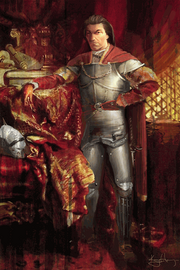
Kory Heinzen's portrait of the human Kain.
A Kory Heinzen portrait of Vorador, a vampire.
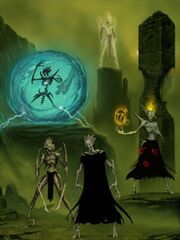
Steve Ross' concept art of the Hylden.
Blood Omen: Legacy of Kain concept art of a wolf.
Kory Heinzen's Legacy of Kain: Defiance concept of a golem.
Kory Heinzen's Legacy of Kain: Defiance concept of an Archon.
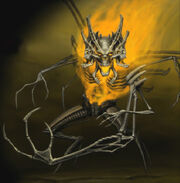
Soul Reaver 2 artwork of a demon.
Kory Heinzen's Legacy of Kain: Defiance concept of a Revenant.
Soul Reaver 2 concept art of Raziel (a wraith).
Nosgoth's most prominent sapient races include:
- The humans: A constant feature in the land's history, Nosgoth's humans are closely akin to their real-world counterparts. Despite their frailty, they have the potential to become extremely powerful sorcerers as well as formidable warriors. Originally primitive, "hairless apes cowering in caves", they became more civilized beings thanks to the intervention of the Hylden.[13] Although spirited and numerous, they are described as "simply unenlightened... and vulnerable to manipulation" - "they fear what they don’t understand; and they despise what they fear". From Nosgoth's early history and onward, humans are typically the dominant species in the world - they launched numerous crusades against the vampires, nearly bringing them to extinction at least three times. However, by the Soul Reaver era, they have become domesticated by Kain's empire, reduced to a tiny population of hunters and citizens kept alive solely to make existence for the vampire fledglings more challenging.[18]
- The vampires: The vampires originated as an entirely distinct race and culture. However, their piety-driven rivalry with the Hylden, and the subsequent war, led to the extinction of this ancient species. Their bloodline was partially preserved by the passing of their blood curse on to humans; even in early eras, the lineage of the vampires consists exclusively of former humans who have received this "dark gift".[13] All vampires in Nosgoth share certain traits; most characteristic are their constant, insatiable thirst for red blood, their immortality/longevity, their sterility, and their heightened durability and regenerative capacities. Four highly-varied generations of vampire have existed throughout history, each with other common powers and physical attributes. A unique, universal quality of Nosgoth's vampires is their capacity to physically evolve - as time passes, they tend to experience growth spurts, emerging in more "divine" or "mutated" forms, with new abilities and vulnerabilities dictated by their personality and personal nature.[13][19][30][31]
- The Ancient Vampires: The first generation of vampires, with black wings, "blue skin and cloven hands". The ancients, originally mortal, were considered "godlike" - "the wisest, strongest, most noble race" - but their attempts to impose the doctrine of the Elder God on the Hylden resulted in their downfall. After they banished their foes to the Demon Realm by summoning the Pillars of Nosgoth, the Hylden retaliated by afflicting them with a predatory blood-thirst. Despite their incredible power, their civilization fell shortly afterward, with many ancients taking their own lives, and others falling victim to the human Guardians' revolt. By Nosgoth's early history, Janos Audron was left the sole surviving specimen of their once-great race.
- The second generation of vampires: As the ancient vampires' civilization declined, they began to pass the blood curse on to humans, bestowing these fledglings with the essence of their bloodline. As they evolved, the former humans adopted a few of the ancients' physical traits, such as cloven, tridactyl hands and bidactyl feet, but were still markedly different; they "seemed to retain much of their former humanity".[32] When their population started to noticeably increase, the Circle of Nine instated the order of the Sarafan to exterminate them, and forced them into seclusion.[10] In latter timelines, this generation was indeed eradicated with the death of Vorador in the Blood Omen era, though the vampire race would live on.
- The post-Blood Omen era vampires: In the fourth timeline, after the collapse of the Pillars, Vorador (having been resurrected) sired many new vampires single-handedly, collaborating with Kain to revive their kindred and seize control of Nosgoth.[24][25] This new incarnation of the race stemmed entirely from his bloodline, but otherwise did not seem dissimilar to the second generation which preceded it. These vampires were also human-like in appearance, with pallid skin and dress styles dictated by Kain himself during his tenure as their general.[33] Each one was able to communicate via the Whisper; on top of this, they were all capable of mastering a personalized dark gift, and could absorb each other's veins to gain new gifts.
- The Soul Reaver era vampires: After Kain raised his lieutenants in the Tomb of the Sarafan, the lieutenants, in turn, raised vampire clans of their own from human corpses - the Dumahim, the Melchahim, the Rahabim, the Razielim, the Turelim and the Zephonim.[11][19] Kain's descendants were very different from other vampires in many respects; because Kain was raised by necromancy, his children had a unique heritage, and they could not be "turned" by the traditional blood gift.[11][13] Their growth spurt process was negatively influenced by Kain's spiritual corruption; they would pupate, evolving much faster than their ancestors had, and would devolve into "grotesque" monsters as the aeons passed.[19][28] Each clan's strength was determined by the amount of Kain's soul its patriarch had received, and individual vampires seemed more homogeneous - they tended to uniformly adopt the traits, abilities and physical makeup of their clan leader instead of developing unique powers.[11]
- The Hylden: An elder race distinguished by their aptitude for technology and prosaism, with distinctively protrusive, crested bone structures, short wing-like appendages, irregular musculature, and pale skin ranging from alabaster white to light brown or green. They rejected the Wheel of Fate, and were oppressed by its advocates, the ancient vampires, to whom they were similar in power but "different in method and intention". Initially fair of form, the Hylden were banished to the Demon Realm by the vampires at the conclusion of a war between both races, and its chaotic magics distorted their bodies into a "warped parody" of their "former beauty". Over the aeons, they developed glyph magic and other scientific instrumentation to keep the corrupting influence of their prison at bay, scratching to gain a foothold back into the Material Realm.[34] The Hylden were able to view the time-stream through undisclosed means, and were thus able to engineer (and capitalize on) the historical paradoxes perpetrated by Kain and Raziel, to an extent.[28]
- The pre-banishment Hylden: Nosgoth's lore and ancient imagery suggests that even prior to their banishment, the Hylden were inquisitive and scientifically-adept, but also graceful and elegant physiologically.[34] However, during the war, some of their number planned to resort to mass genocide in order to claim victory. During or directly after their imposed exile, they unleashed a non-lethal (but still indirectly fatal) retaliation on their enemies: the blood curse. Ostensibly, the Binding effectively resulted in the extinction of this sub-race, but at least one of the Hylden - the Seer - seemed to have evaded banishment, and retained her youthful appearance long into the post-Blood Omen era.[28]
- The post-banishment Hylden: After their banishment, the Hylden physically degenerated, rendered "hideous" and emaciated; for the most part, whether they were inherently malicious or, as they suggested, driven mad by the nature of the Demon Realm, it was clear that they resented their banishment in the strongest terms, and sought revenge against the vampires. At least one of their leaders extensively plotted to return to the Material Realm, raising a massive army and orchestrating the corruption of the Pillars.[23] From behind the walls of their prison, the Hylden were able to possess Material corpses and - at times - living beings, and used these vessels to significantly influence Nosgoth's history even beyond the physical realm.[23] Although Kain eventually impeded their progress, they promised to return.
Apart from major sapient races, Nosgoth is also inhabited by a wide variety of creatures, most of which are supernatural to some extent. With a few exceptions, these can be both loosely and stringently grouped into wider creature categories or families:
- Animals: The typical fauna of the Material Realm, such as bats, crows, dogs, fish, horses and wolves. Though rarely encountered by Kain and Raziel, they were a constant presence in the land's ecology.
- Animated entities: Naturally inanimate objects which have been given a form of life or animation by either magic or technology. These include dolls, statues and other constructs.
- Archons: Mindless, shark-like agents of the Elder God, tasked with eternally hunting the Spectral Realm to feed their master with lost souls. When weakened, they could be devoured in turn.
- Blobs: Amorphous, gelatinous beings, with no blood, but with a limited form of sentience. They usually inhabit the land's more desolate caves or sewers, preying upon intruders.[35]
- Demons: Monsters native to the Demon Realm, capable of shifting into the Material or Spectral Realms. Generally subservient to the Hylden, the demons are a highly-diverse species, manifesting in many forms.[28]
- Mutants: Aberrant, unnatural monstrosities created by the Dark Eden triad. Usually formed as fusions of two creatures (such as half-insect and half-mammals), they possessed green blood.[35]
- Revenants: Long-deceased corpses which have been possessed by Hylden souls; their eyes universally flare with green fire. Though subject to physical limitations, they serve as adequate vessels for their Hylden hosts.
- Shades: Immaterial beings of shadow, capable of manifesting in the Material and Spectral Realms. They are formed from the fragments of restless, half-devoured souls, and have the power to steal elemental energy.[3]
- Sluagh: The feral scavengers of the Underworld. Considered jackal- and vermin-like, Sluagh exist only in the Spectral Realm, but are not aligned to the Elder. The souls they devour can never find their rest.
- Specters: Sentient souls who linger in the Spectral Realm, normally restricted to haunting a limited area. Some specters could harm other Spectral creatures, and manifest in the Material Realm as apparitions.
- Undead: In a broad sense, deceased creatures (other than vampires and revenants) who are animated and continue to inhabit the Material Realm. They are typically identifiable by their distinct black blood.
- Wraiths: Entities (other than Archons, Sluagh and specters) native to the Spectral Realm. If they manifested in the Material Realm through whichever means, they could be identified by their blue blood.
Beyond these groupings, other creatures and beings which did not obviously fall into any known race or classification also existed in Nosgoth. Perhaps the most notable of these was the Elder God, a gigantic "squid"-like, deified entity which dwelled deep in the earth, and existed in both the Material and Spectral Realms.
Factions
Conflict in Nosgoth's history, on a very basic level, is fought - both overtly and covertly - between four sides in a far-reaching power-struggle: the agents and representatives of the humans, vampires, Hylden and Elder God. Divisions and events, though, entail that these races sometimes split into sub-groups, each with their own agenda. Throughout history, there have been a plurality of these factions and sub-factions; the major known ones are listed below.
Culturally, Nosgoth is multifaceted, and morality is not usually one-sided; for instance, "there are many religious beliefs, depending on who you are and what time period you are in", and "everyone always has their motives for what they're doing - everybody believes they're doing the right thing within their belief system".[5][36]
Kain's symbol as drawn by Daniel Cabuco, used by factions under Kain's command.
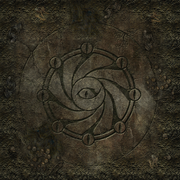
The Elder's God's symbol, seen in the Underworld.
Dave Reyes' concept art of a Soul Reaver-era vampire hunter.
Kory Heinzen's concept art of a female second-generation vampire.
- The ancient, primitive cult: A cult of Elder God worshippers, which presumably operated in the Subterranean Ruins before Nosgoth's recorded history.[13]
- The Cabal: A vampire-led resistance movement in Meridian, formed and led by Vorador and his descendants to oppose the Sarafan Lord's rule. They were responsible for nurturing Kain back to health after his defeat.
- Cabal contacts: Humans within Meridian who have been attracted to the Cabal's cause for various reasons, usually including the promise of receiving the blood curse.
- The Circle of Nine: The oligarchy of sorcerers responsible for governing the Pillars of Nosgoth. The nine Pillar Guardians are immortal, and, whenever one is killed, a new Guardian is born to assume their vacant role.[37][38]
- The Dark Eden triad: The alliance between the corrupt Guardians Anarcrothe, Bane and DeJoule, who created the Dark Eden in northern Nosgoth and its mutant defenders.
- The demon hunters: The descendants of, and successors to, Moebius's mercenary army. Following the destruction of the vampires and the Pillars' collapse, they turned their efforts to protecting Nosgoth from demon invaders.
- The feral humans: A tribe of uncivilized humans inhabiting the Vampire Citadel, who revered the ancient vampires. They had developed their own language, and attacked interlopers.
- The gypsies: Roving humans with a reputation as purveyors of distrust and superstition, whose advice was to be taken with a pinch of salt: they infamously tinkered with weary travelers' minds.
- The Hash'ak'gik cult: worshippers of the dark god Hash'ak'gik, who was connected to tales of human possession and motivated to destroy the Pillars.[17] They operated in the Avernus region.
- The cenobites: Posing as benevolent priests responsible for basic law enforcement, health care and political representation in the city of Avernus, but secretly Hash'ak'gik worshippers.
- Kain's assassins: The band of human brigands discreetly hired by the Death Guardian, Mortanius, to murder Kain. Kain himself destroyed them following his resurrection as a vampire.
- Kain's empire: The mighty empire created under Kain's rule following the collapse of the Pillars. In later centuries, it had grown to encompass and dominate the very corners of Nosgoth.
- The Council: The six clan leaders of Kain's empire, formerly the Sarafan warrior inquisitors. They devolved into monsters later in the land's history.
- The vampire worshippers: Opportunistic humans, led by the Priestess, who looked upon Kain's vampires as gods, and deified them as their masters, carrying out human sacrifice to appease them.
- Kain's vampire army: An army formed by Kain from Vorador's descendants in hopes of returning Nosgoth to vampire rule. They were soon opposed, and, ultimately, destroyed, by the revived Sarafan order.
- The legions of the Nemesis: A long-prophesied army destined to massacre Nosgoth.[12] It manifested in the north under the command of the Nemesis (formerly the boy-king William the Just).
- The Lion Throne: The formal title for the Willendorf monarchy and aristocracy, whose influence spread as far as Avernus and Coorhagen.
- The army of the Last Hope: Willendorf's army, which Kain rallied to defend Nosgoth from the legions of the Nemesis.
- Moebius's mercenary army: An army of citizens and mercenaries led by Moebius in tribute to the vampires' victims, most notably William the Just. Their crusade was monumentally successful.
- The Sarafan (Nosgoth's early history): A monastic order of vampire-hunting warrior-priests, brought into existence by the Circle to combat Nosgoth's rising vampire population. After the vampire purge ended, they faded from history.
- The Sarafan warrior inquisitors: The elite commanders of the Sarafan, whose deaths marked the decline of the brotherhood.
- The Sarafan (post-Blood Omen era): A new vampire-hunting order created and led by the Sarafan Lord, connected to the original Sarafan in name only. Their regime led to the introduction of glyph magic and other technology.
- The glyphwrights: A select caste of the Sarafan Lord's Hylden scientists, who adopted the guise of humans and engineered the glyph network in Meridian and wider Nosgoth.
- The traitor vampires: Three (or, arguably, four) vampires, formerly loyal to Kain's vampire army, who joined the Sarafan Lord's cause in the spirit of self-preservation.
- The Serioli: The enigmatic yet legendary weapon-masters of Nosgoth, responsible for forging the Iron Sword which eventually killed the human Kain.[14]
- The vampire hunters: The warrior class of Nosgoth's remaining humans following the rise of Kain's empire. They operated from the Human Citadel.
Background
Nosgoth was originally conceived by Silicon Knights' Denis Dyack and Ken McCulloch; McCulloch in particular was cited as the creator of "detailed mythologies in the world of Nosgoth".[39] The setting was originally intended to serve as the game world for an initial concept named The Pillars of Nosgoth, which was sent to Crystal Dynamics and accepted for production with the help of Lyle Hall.[36][39][39][40] The Pillars of Nosgoth was internally referred to as Dyack's "vampire project", evincing that vampires were intended to serve as a central element of the games' mythology from the outset.[40] Early influences in Nosgoth's development included The Wheel of Time and Necroscope - the Pillars of Nosgoth specifically were inspired by cover art from The Pillars of the Earth.[39][39]
During the development of Soul Reaver 2, series director Amy Hennig commented with enthusiasm on the potential of a Legacy of Kain/Nosgoth "expanded universe" media franchise (a concept which has never been realized), comparing it to Star Trek or Star Wars:[36]
Blood Omen: Legacy of Kain image of a "banner" on the Nosgoth paper map.
- "The plan is that in the future we can continue to explore different aspects of Nosgoth's history, with different characters. This is such a rich universe with so much mythology and backstory, and so many interesting players. The analogy we use internally is that we want to establish something like they did with Star Trek or Star Wars - where you have a consistent universe and 'mythology' which can be explored from many different perspectives."
- ―Amy Hennig[36]
A large paper map of Nosgoth was distributed with the Microsoft Windows port of Blood Omen: Legacy of Kain (a less-detailed version had earlier been available in the PlayStation version of the game). For Crystal Dynamics' Soul Reaver 2, this map was adapted and re-drawn. Seeking "to create some fairly new locations that fit better with [their] needs", the developers of Blood Omen 2 "elected to move down the map of Nosgoth into some unexplored areas in the southern regions"; a map of this south-western region of the land can be briefly seen in the Blood Omen 2 introductory cinematic.[41] An official Nosgoth timeline, based on the backstory of Blood Omen: Legacy of Kain and Legacy of Kain: Soul Reaver, was distributed with issue #36 of Official U.S. PlayStation Magazine, and a truncated version of this document was included with the PlayStation 2 release of Soul Reaver 2.[11]
Most of Nosgoth's eras borrow thematic cues from the real world. The Blood Omen era corresponds to medieval Europe, whereas the dystopian Soul Reaver era was intended to exude "a decaying 19th-century industrial aesthetic", and the Victorian-style post-Blood Omen era presents "an industrial revolution [...] but one that followed different lines than one based on fossil fuels".[16][42][43] Despite the inclusion of some industrial and science-fiction elements in Legacy of Kain: Soul Reaver and Blood Omen 2, Nosgoth is not necessarily considered a truly rational universe: it couples instrumentation with a prevalence of magic and fantastical elements, from its very earliest historical eras to its very latest.
Notes
- No demonym for Nosgoth has ever been given or acknowledged in the games; the only official indication of one was presented by Silicon Knights, who cited their preferred gentilic as "Nosgothian" in The Complete Guide To Legacy of Kain.[44] The same variation was later repeatedly used by an interviewer who was indirectly quoting from Crystal Dynamics' Andrew Bennett.[45] Among the fan community, however, the demonym "Nosgothic" is more frequently used.[46][47]
- The etymology of the name "Nosgoth", has never been publicly explained within the series' universe or without, if it even has any. Given the influences behind the games, it may consist of a portmanteau of "Gnosticism" and "Goth", or perhaps "Nosferatu" and "Goth".[36][48]
- Nosgoth has a recognized epoch (in other words, a "reference date" or calendar era such as the real-world Anno Domini or Common Era), but it cannot be properly integrated into the known timeline from the limited information available. In Blood Omen 2, a building in Meridian's Lower City is accompanied by a sign reading "Hill House est. 1246". This is the only time a numbered year or epoch has ever been presented in the series, and it is unknown where the year 1246 should be positioned in relation to the games, or how it corresponds to time as a whole.
- In the non-canonical Raziel and Kain Character Pack for Lara Croft and the Guardian of Light, Nosgoth is jocularly referred to as "another world... and kind of in the past"...[49]
Gallery
Appearances
- Template:Icon-BO1 Blood Omen: Legacy of Kain
- Template:Icon-SR1Comic Legacy of Kain: Soul Reaver comic
- Template:Icon-SR1 Legacy of Kain: Soul Reaver
- Template:Icon-SR2 Soul Reaver 2
- Template:Icon-BO2 Blood Omen 2
- Template:Icon-DefianceComic Legacy of Kain: Defiance comic
- Template:Icon-Defiance Legacy of Kain: Defiance
Non-canonical
- Template:Icon-TDP Legacy of Kain: The Dark Prophecy (cancelled)
See also
- Material Realm
- Spectral Realm
- Demon Realm
- Timelines
- Paradoxes
- The Pillars of Nosgoth
- The Circle of Nine
- The Soul Reaver
- Vampires
- Humans
- Hylden
- Template:Icon-NR Map of Nosgoth (Blood Omen: Legacy of Kain) at Nosgothic Realm (by Tenaya and Guilherme Coelho).
- Template:Icon-NR Map (Legacy of Kain: Soul Reaver) at Nosgothic Realm (by Tenaya and Guilherme Coelho).
- Template:Icon-NR Map of Nosgoth (Soul Reaver 2) at Nosgothic Realm (by Tenaya and Guilherme Coelho).
- Template:Icon-NR Maps (Blood Omen 2) at Nosgothic Realm (by Tenaya and Guilherme Coelho).
References
- ↑ Template:Icon-GS Legacy of Kain: Defiance Designer Diary #1 at GameSpot, page 1 (by Richard Lemarchand)
- ↑ 2.0 2.1 2.2 2.3 2.4 2.5 2.6 2.7 2.8 2.9 Template:Icon-DC Soul Reaver 2: Background Story at Dark Chronicle (by Marie Tryhorn)
- ↑ 3.0 3.1 3.2 Template:Icon-Eidos Answers to questions from the Defiance team at the Eidos Forums (by Chris@Crystal)
- ↑ Template:Icon-DC Moebius' Museum at Dark Chronicle (by Marie Tryhorn)
- ↑ 5.0 5.1 5.2 Template:Icon-Eidos Extra question for Chris at the Eidos Forums (by Hanpolo), post #19 (by Chris@Crystal)
- ↑ Template:Icon-DCab Question on Nosgoth at DCabDesign (by Strands of Night), post #3 (by Daniel Cabuco)
- ↑ Template:Icon-IGN Blood Omen 2 Interview at IGN (by Sam Newman)
- ↑ Template:Icon-DC Soul Reaver 2 (The Swamp) (archived at Dark Chronicle)
- ↑ Template:Icon-DC Soul Reaver 2 (Raziel) (archived at Dark Chronicle)
- ↑ 10.00 10.01 10.02 10.03 10.04 10.05 10.06 10.07 10.08 10.09 10.10 10.11 10.12 10.13 10.14 10.15 Template:Icon-DC Soul Reaver 2: Historical Timeline at Dark Chronicle (by Marie Tryhorn)
- ↑ 11.00 11.01 11.02 11.03 11.04 11.05 11.06 11.07 11.08 11.09 11.10 11.11 11.12 11.13 11.14 11.15 11.16 11.17 11.18 11.19 11.20 11.21 11.22 11.23 11.24 11.25 11.26 11.27 11.28 11.29 11.30 11.31 11.32 11.33 Template:Icon-NR GLoK Interviews with Amy Hennig at Nosgothic Realm (by Raziel Fan), post #5 (by RazielFan)
- ↑ 12.0 12.1 12.2 Template:Icon-DC The Players at SK: The Complete Guide To Legacy of Kain (archived at Dark Chronicle)
- ↑ 13.0 13.1 13.2 13.3 13.4 13.5 13.6 Template:Icon-Eidos Warp's answers from Amy at the Eidos Forums (by blincoln)
- ↑ 14.0 14.1 Cite error: Invalid
<ref>tag; no text was provided for refs namedBO1-Misc - ↑ Template:Icon-Prima Prima Games / Ian Osborne. Blood Omen: Legacy of Kain: Official Game Secrets. (1996)
- ↑ 16.0 16.1 Template:Icon-IGN Interview With a Vampire: Blood Omen 2 at IGN (by Douglass C. Perry)
- ↑ 17.0 17.1 17.2 17.3 Template:Icon-DC Miscellaneous Questions & Answers at SK: The Complete Guide To Legacy of Kain (archived at Dark Chronicle)
- ↑ 18.0 18.1 18.2 18.3 18.4 18.5 18.6 18.7 Template:Icon-DC Soul Reaver: Background Story at Dark Chronicle (by Marie Tryhorn)
- ↑ 19.0 19.1 19.2 19.3 Cite error: Invalid
<ref>tag; no text was provided for refs namedSR1-Manual-US - ↑ Cite error: Invalid
<ref>tag; no text was provided for refs namedSR1-Misc - ↑ Template:Icon-GS Blood Omen 2 Q&A at GameSpot (by Sam Newman)
- ↑ Template:Icon-TLW My Visit to Crystal Dynamics at The Lost Worlds (by Ben Lincoln)
- ↑ 23.0 23.1 23.2 23.3 23.4 23.5 23.6 Template:Icon-TLW Question and Answer with Amy Hennig at The Lost Worlds (by Ben Lincoln)
- ↑ 24.0 24.1 Template:Icon-TLW FAQ at The Lost Worlds (by Ben Lincoln)
- ↑ 25.0 25.1 Template:Icon-TLW The Resurrection of Vorador at The Lost Worlds (by Ben Lincoln)
- ↑ Template:Icon-DC Bloodomen 2 (Story) (archived at Dark Chronicle)
- ↑ 27.0 27.1 Template:Icon-DC Blood Omen 2: Background Story at Dark Chronicle (by Marie Tryhorn)
- ↑ 28.0 28.1 28.2 28.3 28.4 Template:Icon-TLW Question and Answer with Jen, Richard, and Kyle at The Lost Worlds (by Ben Lincoln)
- ↑ Template:Icon-DC Defiance: Background Story at Dark Chronicle (by Marie Tryhorn)
- ↑ Template:Icon-NR GLoK Interviews with Amy Hennig at Nosgothic Realm (by Raziel Fan)
- ↑ Template:Icon-DA Zephon at deviantART (by SpectralJin)
- ↑ Template:Icon-DCab Vampire's attire in Nosgoth at DCabDesign (by majinkura), post #17 (by Daniel Cabuco)
- ↑ Template:Icon-GS Blood Omen 2 Designer Diary #1 at GameSpot, page 2 (by Steve Ross)
- ↑ 34.0 34.1 Template:Icon-DCab Blood Omen 2 at DCabDesign (by Divine Shadow), post #2 (by Daniel Cabuco)
- ↑ 35.0 35.1 Template:Icon-DC Strategies to Aquiring Each Spell at SK: The Complete Guide To Legacy of Kain (archived at Dark Chronicle)
- ↑ 36.0 36.1 36.2 36.3 36.4 Template:Icon-NR GLoK Interviews with Amy Hennig at Nosgothic Realm (by Raziel Fan), post #4 (by RazielFan)
- ↑ The Pillars at the Soul Reaver 2 official site
- ↑ Template:Icon-Eidos Questions reguarding BO1. at the Eidos Forums (by TheElderGodofNosgoth), post #16 (by Anubis_Orr)
- ↑ 39.0 39.1 39.2 39.3 39.4 Template:Icon-NR Recreated PSXnation.com Interview with Denis Dyack at Nosgothic Realm Cite error: Invalid
<ref>tag; name "PSN" defined multiple times with different content Cite error: Invalid<ref>tag; name "PSN" defined multiple times with different content - ↑ 40.0 40.1 Template:Icon-Gamasutra Playing Catch-Up: GEX's Lyle Hall at Gamasutra (by Alistair Wallis)
- ↑ Template:Icon-GS Blood Omen 2 Designer Diary #1 at GameSpot (by Steve Ross)
- ↑ Template:Icon-PSN Behind the Classics: Amy Hennig Talks Soul Reaver Secrets at the PlayStation Blog (by Sid Shuman and Amy Hennig)
- ↑ Template:Icon-GS Blood Omen 2 Designer Diary #1 at GameSpot, page 3 (by Bret Robbins and Mike Ellis)
- ↑ Template:Icon-DC How Did They Do That? at SK: The Complete Guide To Legacy of Kain (archived at Dark Chronicle)
- ↑ Template:Icon-GS Legacy of Kain: Soul Reaver 2 Feature Preview at GameSpot, page 2 (by Miguel Lopez)
- ↑ Template:Icon-NR Nosgothic Realm
- ↑ Template:Icon-DC Blood Omen: Nosgothic Businesses at Dark Chronicle (by Marie Tryhorn)
- ↑ Template:Icon-DCab Vampire's attire in Nosgoth at DCabDesign (by majinkura), post #4 (by Daniel Cabuco)
- ↑ Template:Icon-LCGOL Crystal Dynamics. Lara Croft and the Guardian of Light. (Eidos Interactive). PlayStation 3. (August 18, 2010)
Template:Navbox-Nosgoth-Geography Template:Navbox-Nosgoth-History Template:Navbox-Nosgoth-Inhabitants
